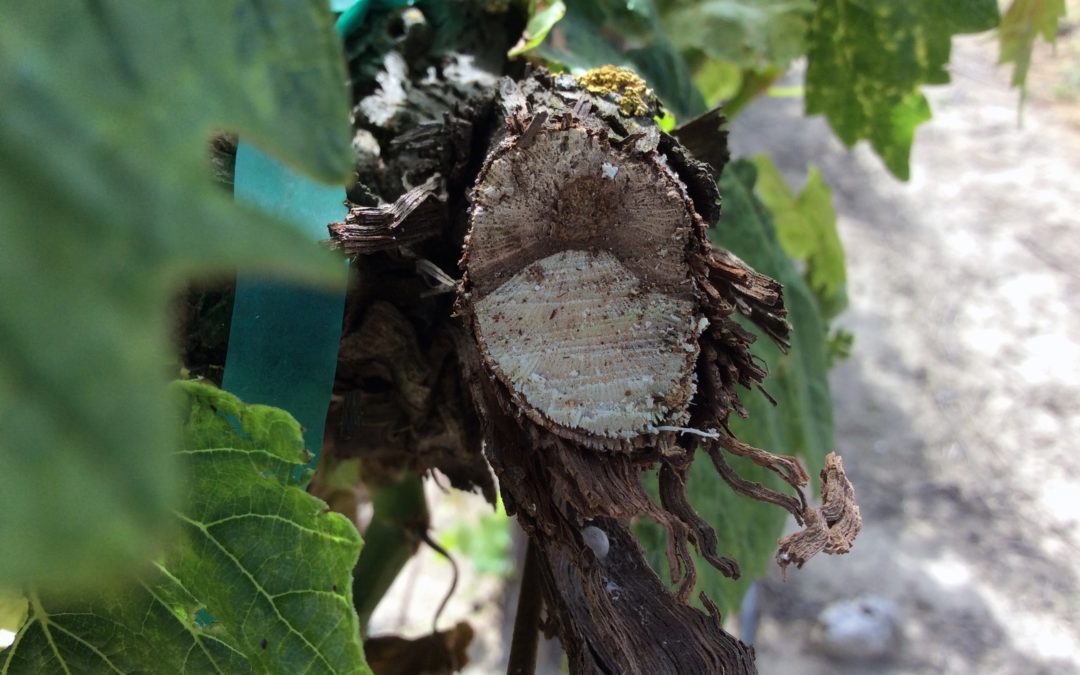FEBRUARY 10, 2020. BY STAN GRANT, VITICULTURIST.
Cordon and trunk diseases are among the most serious threats to the longevity of vineyards. They are insidious fungal diseases of grapevine wood that typically do not become apparent as distorted shoots or dead spurs until vines are 8 to 10 years old. By the time the vineyard is about 20 years old, over 90 % of the vines in vineyards of susceptible varieties may be infected (Figure 1). During the same time, yields decline and if the diseases are left unchecked, the vineyard may become unprofitable near the end of its second decade.
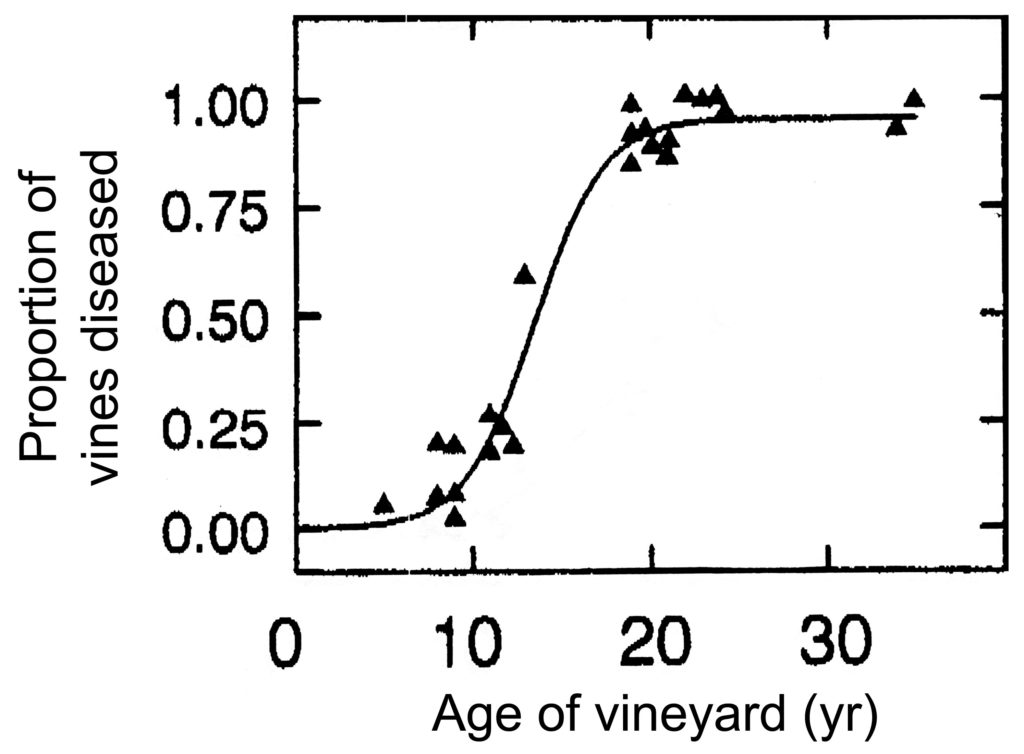
Figure 1. Cordon and trunk disease infection incidence for susceptible varieties without management intervention. (Source: Duthie, et. al., 1991.)
Cordon and trunk diseases have gone by several names in California, including Eutypa dieback disease, bot canker, dead arm disease, and black measles. The fungi that cause these diseases are numerous. Further, in most instances more than one pathogenic fungus is involved with any particular infection.
Cordon and trunk disease pathogens lay dormant during much of the year while conditions are dry, but they become active with the first rains of late autumn or early winter. During periods of rain, fruiting structures on infected wood release fungal spores into the air and they move with it. Infection occurs when spores land on fresh wounds on cordons and trunks, germinate and grow into the wood.
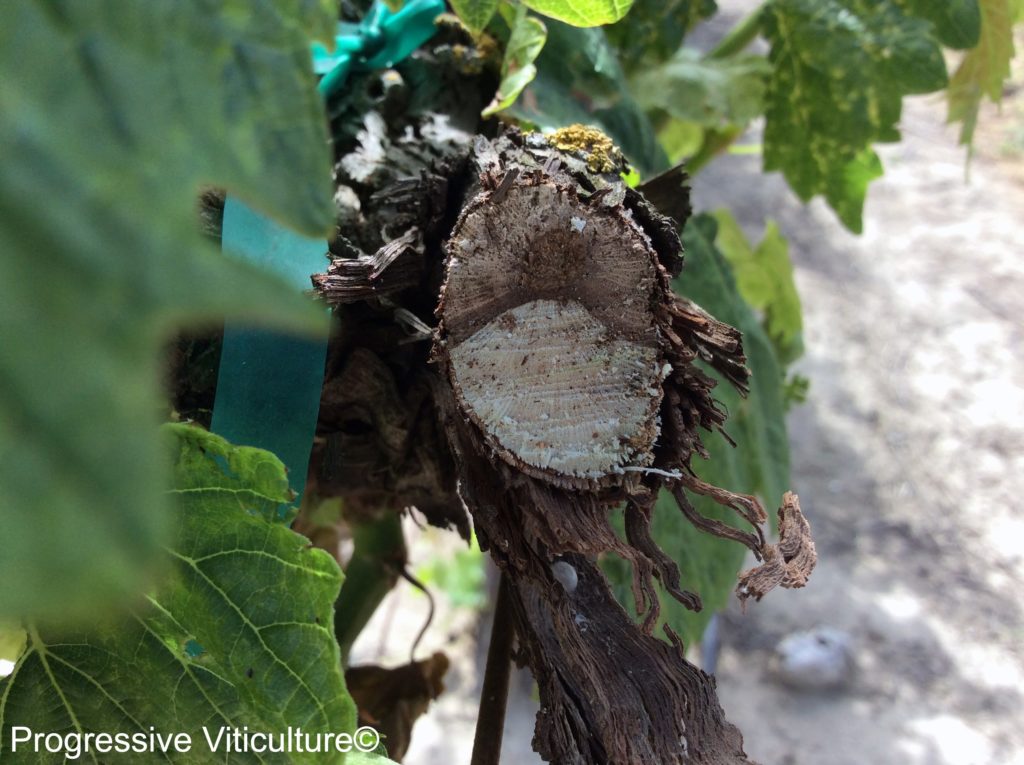
Figure 2. Cordon cross section with fungal disease canker. (Photo source: Progressive Viticulture©)
The leading edge of the infection advances away from the wound at a rate of 2 to 5 inches per year, depending on the fungus. Extending behind the leading edge is an ever-widening pie-shaped canker of deadwood, which, after extending many inches, engulfs the entire cordon (Figure 2). The spurs above cankers also die but may produce deformed and yellowed shoots before failing (Figure 3). After many years, the canker can extend down the trunk and kill the vine.
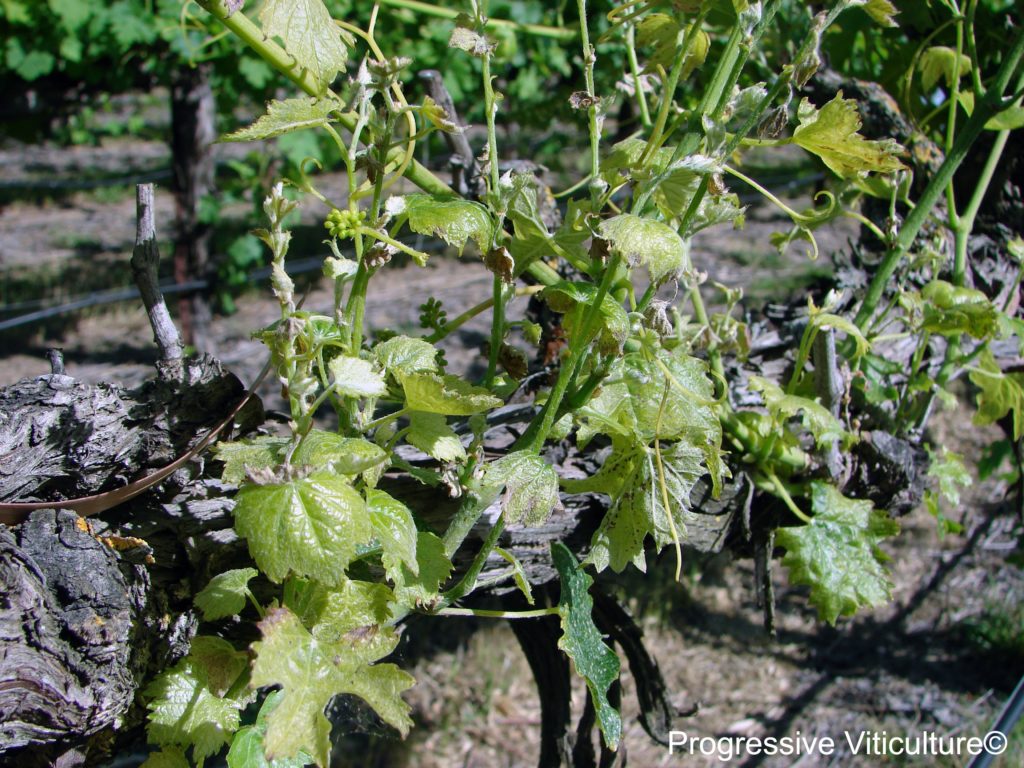
Figure 3. Yellowed and distorted foliage associated with a Eutypa canker. (Photo source: Progressive Viticulture©)
Susceptibility to cordon and trunk diseases varies among winegrape varieties, but no variety is immune. Cabernet Franc, Cabernet Sauvignon, Chenin blanc, Colombard, Grenache, Petite Sirah, Pinot Grigio, Rubired, Ruby Cabernet, Orange Muscat, Sauvignon blanc, and Syrah are highly susceptible, but Alicante Bouschet, Carignane, Chardonnay, Pinot blanc, and Tempranillo vineyards are also commonly infected. A few varieties appear to have low disease susceptibility, including Barbera, Merlot, Semillon, and Zinfandel (Figure 4). Wound size is also a disease risk factor, with the likelihood of infection increasing with the surface area of the wound.
Fortunately, cordon and trunk diseases are manageable. As with all diseases, the first line of defense is disease avoidance. Disease inoculum in the air is highest with the first rains and it diminishes over the course of the rainy season. Moreover, pruning wounds made in December remain highly vulnerable to infection for three or more weeks but wound susceptibility steadily decreases as the winter progresses until wounds made in March are barely susceptible. Further, to lessen the opportunity for infection at any time during the winter, avoid pruning immediately before or during a forecasted rain.
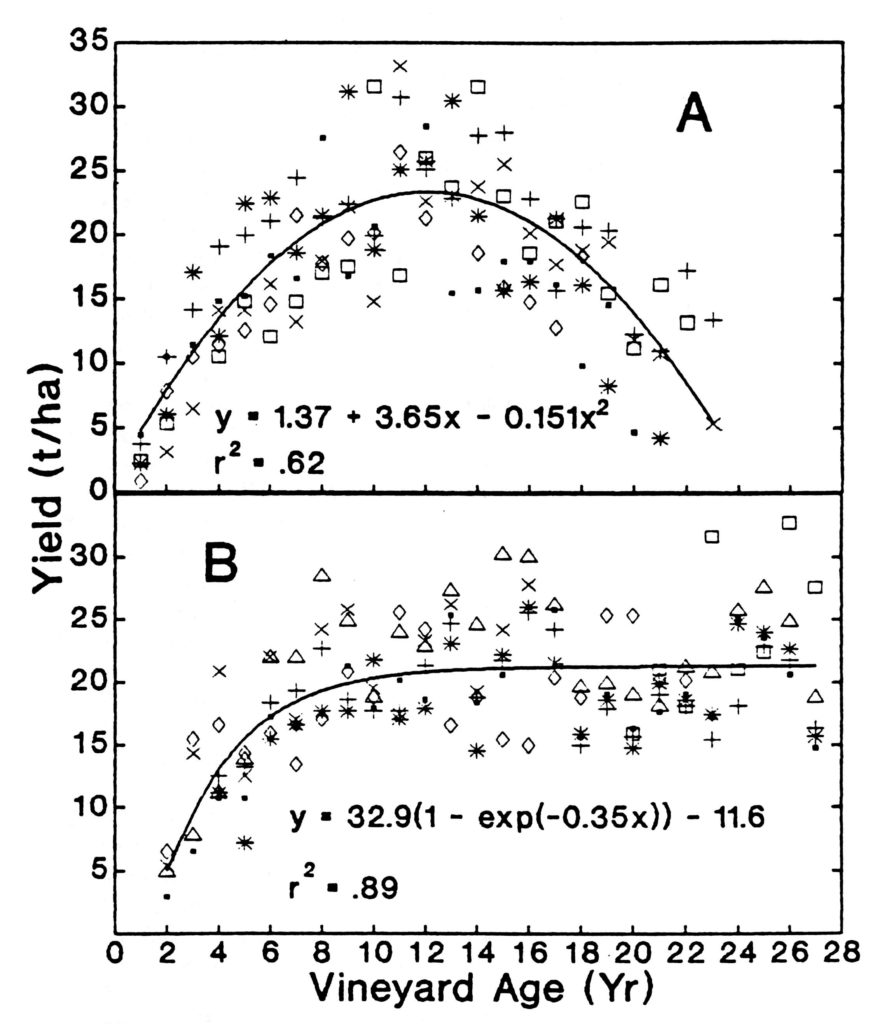
Figure 4. Fruit yield as a function of vineyard age for (A) a highly susceptible variety (Chenin blanc) and a low susceptibility variety (Barbera) with regard to cordon and trunk diseases. (Source: Gallo Vineyards, Inc. via Munkvold, et. al., 1994)
Of course, late pruning is not always possible with large vineyard operations or when labor is scarce. Under these circumstances, there are still measures one can take to minimize infection. For instance, vineyards can be mechanically prepared for long spurs (Figure 5). This act reduces the time required for hand pruning, thereby allowing for later initiation of final pruning. Also, quadrilateral training with 1-bud spur pruning reduces the impact of spur loss to the disease on fruit yield compared to bilateral cordon training with 2-bud spurs.
Larger operations ought to prioritize vineyard blocks in pruning schedules by vineyard age, disease susceptibility, and value to the operation. For example, older blocks near their end of the useful life may be pruned ahead younger blocks that have not yet paid for themselves. It is also prudent to prune blocks with a vineyard designation and a high value per ton near the end of the schedule.
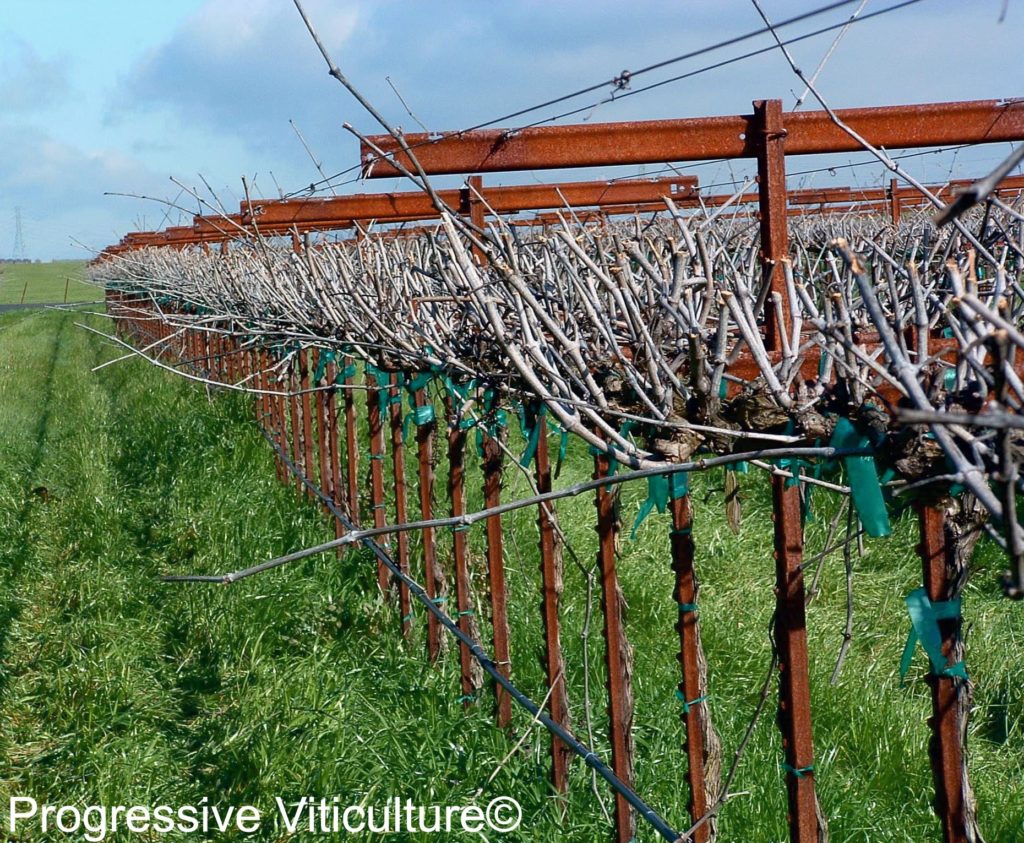
Figure 5. Prepruned Syrah vines on a Wye trellis. (Photo source: Progressive Viticulture©)
When avoidance is not possible, pruning wound protection can minimize canker diseases. Rally and Topsin fungicides are registered for spray application to cordons. These two fungicides differ in effectiveness for controlling specific cordon and trunk disease pathogens. Therefore, using them together provides more complete disease control. Boric acid further broadens the activity of these fungicides with only a small increase in material costs. A penetrating adjuvant is a final ingredient for an efficacious pruning wound protection tank mix.
To be most effective, apply the fungicides within a few hours of pruning before wounds begin to dry. While these fungicides are fast-acting, they are not long-lived and reapplication may be required after rains and after a few weeks to ensure adequate protection during early winter.
For infected vines, surgery is the only remedy. The UC recommendation is to cut out infected portions of cordons beyond the leading edge of cankers to where only healthy wood is visible. I prefer to cut off entire infected cordons to ensure complete disease elimination and to simplify cordon retraining. To ease disease identification while minimizing yield loss, wait for surgery until a cordon has two or at most, three dead spurs. Do not wait for greater spurs loss. Doing so will increase the risk of incomplete diseased wood removal and the risk of additional infections due to spore release from infected wood within the vineyard. To sanitize a vineyard of disease spores, remove all abscised wood and burn it.
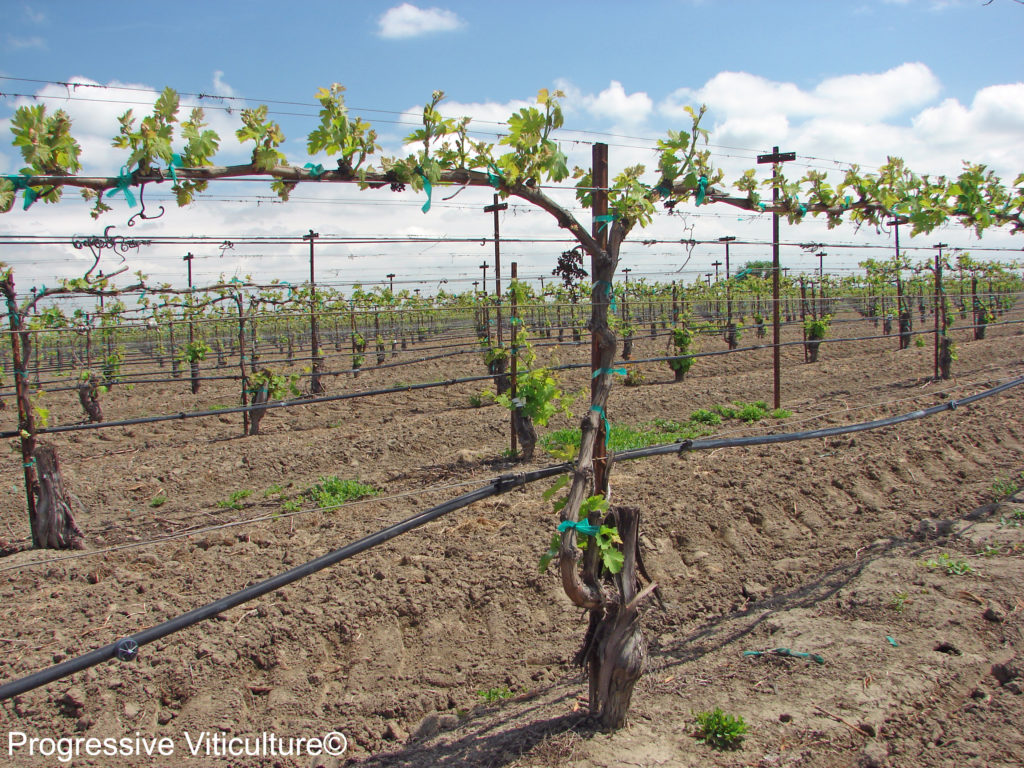
Figure 6. A retrained Cabernet Sauvignon vineyard the second year after surgery to remove diseased cordons and trunks. (Photo source: Progressive Viticulture©)
For a few very large vineyard operations, surgery of entire blocks is a workable practice for controlling disease (Figure 6). In some instances, the vines are not retrained but grafted to a new variety that is in greater demand in the current market. The success of this strategy requires the original vines and bud wood to be free of virus pathogens.
By consistently using the cordon and trunk disease management strategies and tactics presented here, you can prolong the productive life of your vineyard, perhaps indefinitely.
A version of this article was originally published in the Mid Valley Agricultural Services December, 2009 newsletter.
Further Reading
Duthie, JA; Munkvold, GP; Marios, JJ; Grant, RS; Chellimi, DO. Progress of Eutypa dieback of grapevine. Unpublished report.
Duthie, JA; Munkvold, GP; Marios, JJ; Grant, RS; Chellimi, DO. Relationship between age of vineyard and incidence of Eutypa dieback. (Abstr.) Phytopathology. 81: 1183. 1991.
Epstein, L; Kaur, S; VanderGheynst, JS. Botryosphaeria-related dieback and control investigated in noncoastal California grapevines. California Agriculture. pp. 161-166. Oct-Dec 2008.
Gubler, WD: Lantham, SR; Vasquez, SJ; Eskalen, A. Esca (black measles) and Petri disease. In Grape pest management. 3rd Ed. Bettiga, LJ (Ed.). University of California Agricultural and Natural Resources, Oakland, CA. Publication 3343. Pp. 120-125. 2013.
Gubler, WD; Mugnai, L; Surico, G. Esca, Petri, and grapevine leaf strip diseases. In Compendium of Grape Diseases. 2nd ed. Wilcox, WF; Gubler, WD; Uyemoto, JK (ed.). APS Press, St. Paul, MN. pp. 57-61. 2015.
Gubler, WD; Rolshausen, P; Trouillas, F. Eutupa dieback. pp. 110-116. In Grape pest management. 3rd Ed. Bettiga, LJ (Ed.). University of California Agricultural and Natural Resources, Oakland, CA. Publication 3343. pp. 104-109. 2013.
Kasimatis, AN; Moller, WJ. Eutypa fungus causes grapevine dieback. California Agriculture. p. 9. May, 1978.
Leavitt, GM. Canker diseases of grapevines. U. C. Coop. Ext, Madera. Undated report.
Moller, WJ; Kasimatis, AN. Protection of grapevine pruning wounds from Eutypa dieback. Plant Disease. 64, 278-280. 1980.
Moller, WJ; Kasimatis, AN. Fungicide protects grapevines from Eutypa. California Agriculture. p. 8. Jan-Feb, 1981.
Munkvold, GP; Marois, JJ. The effects of fungicides on Eutypa lata germination, growth, and infection of grapevines. Plant Disease. 77, 50-55. 1993.
Munkvold, PG; Duthie, JA; Marois, JJ. Spatial patterns of grapevines with Eutypa dieback in vineyard with and without perithecia. Phytopathology. 83, 1440-1446. 1993.
Munkvold, PG; Duthie, JA; Marois, JJ. Reductions in yield and vegetative growth of grapevines due to Eutypa dieback. Phytopathology. 84, 186-192. 1994.
Petzoldt, CH; Moller, WJ; Sall, MA. Eutypa dieback of grapevine; seasonal differences in infection and duration of susceptibility of pruning wounds. Phytopathology. 71, 540-543. 1981.
Rolshausen, PE; Gubler, WD. Use of boron for the control of Eutypa dieback of grapevines. Plant Disease. 89, 734-738. 2005.
Rolshausen, P; Sosnowski, M; Touillas, FP; Gubler, WD. Eutypa dieback. In Compendium of Grape Diseases. 2nd ed. Wilcox, WF; Gubler, WD; Uyemoto, JK (ed.). APS Press, St. Paul, MN. pp. 57-61. 2015.
Sosnowski, M; Creaser, M; Wicks, T. Managing Eutypa dieback of grapevines by remedial surgery. Australian and New Zealand Grapegrower and Winemaker. pp. 35-39. Sep, 2004.
University of California Integrated Pest Management Guidelines: http://ipm.ucanr.edu/PMG/selectnewpest.grapes.html
Urbez-Torres, JR; Gubler, WD; Leavitt, GM. Botryosphaeria Dieback. In Grape pest management. 3rd Ed. Bettiga, LJ (Ed.). University of California Agricultural and Natural Resources, Oakland, CA. Publication 3343. Pp. 104-109. 2013.
Urbez-Torres, JR; Phillips, AJL; Gubler, WD. Botryosphaeria Dieback. In Compendium of Grape Diseases. 2nd ed. Wilcox, WF; Gubler, WD; Uyemoto, JK (ed.). APS Press, St. Paul, MN. pp. 33-39. 2015.
Weber, EA; Trouillas, FP; Gubler, WD. Double pruning of grapevines: a cultural practice to reduce infections of Eutypa lata. American Journal of Enology and Viticulture. 58, 61-66. 2007.
Have something interesting to say? Consider writing a guest blog article!
To subscribe to the Coffee Shop Blog, send an email to stephanie@lodiwine.com with the subject “blog subscribe.”
To join the Lodi Growers email list, send an email to stephanie@lodiwine.com with the subject “grower email subscribe.”
To receive Lodi Grower news and event promotions by mail, send your contact information to stephanie@lodiwine.com or call 209.367.4727.
For more information on the wines of Lodi, visit the Lodi Winegrape Commission’s consumer website, lodiwine.com.

